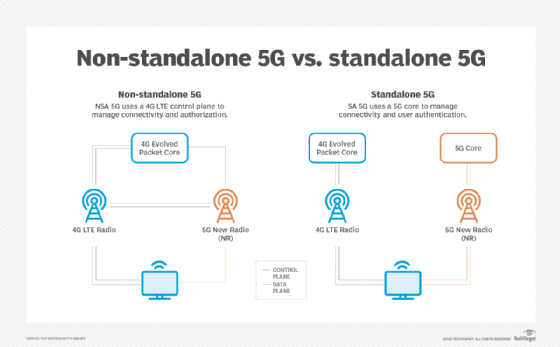5G NSA vs. SA: How do the deployment modes differ?
Non-standalone 5G combines 4G LTE architecture with a 5G RAN. Standalone 5G, on the other hand, uses a 5G RAN and a cloud-native 5G core for connectivity.
Before its release, 5G was touted as a significant upgrade to cellular networking technology. With 5G no longer in its infancy, U.S. mobile network operators have started distributing it nationwide.
MNOs have two main options for 5G deployment: non-standalone (NSA) 5G, which is a 5G radio access network (RAN) that operates on a legacy 4G LTE core, and standalone (SA) 5G networks that include a 5G RAN and a cloud-native 5G core.
Both NSA and SA use the 5G New Radio (5G NR) interface, which enables them to deliver features and capabilities based on the standards defined by the 3rd Generation Partnership Project (3GPP). 5G NR offers myriad use cases, but one of its most essential features is providing a path from 4G LTE to 5G.
Thanks to existing cellular infrastructure, NSA dominated as the top choice for initial 5G deployments among MNOs. But, as SA 5G deployments take off, it's essential to understand their distinctions. Both approaches are valid ways of constructing a 5G network, but the chosen deployment mode determines how efficiently the 5G network operates.
Non-standalone 5G
When it comes to NSA 5G, the clue is in the name: It's 5G that can't stand on its own in terms of infrastructure. NSA is a 5G RAN that operates on a legacy 4G LTE core, known as Evolved Packet Core (EPC), and manages control plane functions. NSA includes a 4G and 5G base station, but the 4G base station takes precedence. Because the NR control plane anchors to EPC, radio frequency signals forward to the primary 4G base station.
NSA 5G, also known as Release 15 by 3GPP, is considered the first stage of 5G. Initial 5G deployments used NSA because MNOs could use their current infrastructure to build a 5G network. Carriers with 4G LTE networks can implement a 5G RAN on their existing architectures. NSA 5G can be a stepping stone for carriers unprepared to make a hefty investment when transitioning from legacy 4G LTE to 5G networks.
However, NSA 5G can't deliver the specific capabilities a pure, unfettered SA 5G network can. For example, NSA doesn't enable low latency -- one of the biggest draws of 5G. Another disadvantage of NSA is that it requires more energy to power 5G networks with 4G infrastructure. According to an IEEE report, 5G NR is more energy-efficient than LTE, but using two different forms of cellular technology massively increases power consumption in a network.
NSA 5G shouldn't be mistaken for dynamic spectrum sharing (DSS), another method of deploying 5G with 4G technology. While NSA creates a 5G network with 4G infrastructure using dual connectivity, DSS permits 4G LTE and 5G NR to coexist in the same frequency band. 5G networks have a variety of spectrum bands available for use, and DSS distributes spectrum between bands based on user demand.
Benefits of NSA 5G
NSA 5G presents several advantages, including the following:
- Reduced costs. MNOs can build a 5G network on top of their existing 4G infrastructure instead of investing in a new, costly 5G core.
- Easy deployment. NSA networks use 4G infrastructure with which MNOs are already familiar, simplifying configuration and update processes.
- Fast rollout. MNOs can release an operational 5G network quicker with NSA by using 4G infrastructure.
- Pathway to SA 5G. MNOs configured NSA 5G networks as a foundation while SA networks were being developed. As SA networks roll out, carriers can replace outdated 4G network elements with 5G infrastructure to manage their existing 5G networks.

Standalone 5G
SA 5G networks include a 5G RAN and a cloud-native 5G core, which NSA networks lack and substitute with a 4G core. Because SA networks have 5G cores, they can perform essential 5G functions and offer advantages, such as reduced latency, improved network performance and the ability to control network management functions with a central controller.
SA requires MNOs to configure and learn an entirely new architecture. As carriers waited for SA technology to mature, most opted to reconfigure their 4G networks to support 5G, as it was cheaper and more convenient.
However, new providers without established 4G core networks couldn't follow that strategy. Because they couldn't rely on a 4G core, they needed to build their 5G infrastructure from scratch. SA could soon take the crown among MNOs as carriers deploy it to take advantage of its improvements over NSA.
The most significant disadvantage of SA is that it's costly to implement and time-consuming for network professionals to learn the new 5G core infrastructure. Regardless, MNOs will likely shift to SA because, while NSA can serve as a step toward 5G networking, it isn't considered "true" 5G due to its reliance on 4G LTE.
Benefits of SA 5G
SA 5G advantages include the following:
- Reduced power consumption. Because SA doesn't need to operate with 4G LTE, it uses only one cellular connectivity method and consumes less power to support a network.
- More 5G use case support. Unlike NSA, SA can deliver essential 5G services, such as improved latency and increased bandwidth caps, to power ultra-fast, scalable networks.
NSA vs. SA: 5G NR specifications
Ultimately, the biggest difference between NSA and SA is how each mode provides 5G. NSA uses a 5G RAN and a 4G LTE core, while SA is an end-to-end 5G network with a 5G RAN and a 5G NR core. Their methods of deployment determine how each mode supports the 3GPP-defined NR specifications.
5G NR specifications include the following:
- Enhanced mobile broadband. Functioning as an extension of 4G, this increases data rates to improve network speeds.
- Massive machine-type communications. These connect up to 1 million devices and facilitate quick, seamless communication.
- Ultra-reliable, low-latency communications. These ensure network reliability by reducing latency to below 5 milliseconds.
All three features support various industries and services, including emerging sectors such as IoT and satellite communications. However, SA 5G is the only deployment mode that supports all three specifications. NSA 5G can only enable enhanced mobile broadband because it has a 4G core that can extend to support the specification. In contrast, SA can enable all three features because it has a more powerful and flexible 5G core.
Many MNOs previously said they were eager to develop SA 5G, but installations are behind. The global economy is in a downturn, and MNOs also find it challenging to earn ROI on 5G. Because carriers have yet to see many lucrative or killer applications that justify the transition to SA 5G, NSA currently reigns supreme.
However, research has found that the advanced capabilities SA 5G offers -- such as enhanced mobile broadband, fixed wireless access and network slicing -- show revenue potential. SA 5G could be the killer use case that increases 5G's ROI and provides a reason to support the transition to SA 5G. Despite the simplicity and inexpensive costs of deploying NSA, carriers should move to SA 5G to reap its most beneficial and anticipated capabilities.
Editor's note:This article was updated in April 2025 to improve the reader experience.
Deanna Darah is site editor for Informa TechTarget's SearchNetworking site.








